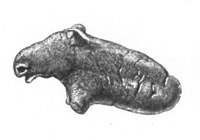Pitted Ware culture
- For the contemporary (ca 4000 BC– ca 2000 BC) North-East European culture, having a similar name, see Pit-Comb Ware culture.
| Preceded by the Pleistocene |
| Holocene Epoch |
|---|
|
|
Blytt–Sernander stages/ages
*Relative to year 2000 (b2k). †Relative to year 1950 (BP/Before "Present"). |


The Pitted Ware culture (ca 3200 BC– ca 2300 BC) was a neolithic Hunter-gatherer culture in southern Scandinavia, mainly along the coasts of Svealand, Götaland, Åland, north-eastern Denmark and southern Norway. It was first contemporary and overlapping with the agricultural Funnelbeaker culture, and later with the agricultural Corded Ware culture.
Objects


The culture has been named after the ornamentation of its pottery, which is usually round pits and horizontal lines. The vessels are uniform and have usually pointed bottoms in order to facilitate positioning in the soil or on the hearth. Their height varies from only a few cm to 40. The settlements on the Swedish east coast have produced large quantities of pottery. At Fagervik on Bråviken in Östergötland archaeologists have found 170 000 shards, but few flint objects. The pottery from Fagervik have provided a chronology with five phases. Fagervik 1 represents pottery from the Funnel Beaker culture while Fagervik 2-4 represents Pitted Ware pottery, Fagervik 3 and 4 are considered typical Pitted Ware pottery. Fagervik 4 is usually very porous because the clay was tempered with limestone. Fagervik 5 contains pottery from the Corded Ware culture.
Tanged arrow heads made from blades of flintstone are abundant on Scandinavia's west coast, while pottery is sparse. The culture was consequently less homogeneous than the contemporary and overlapping agricultural cultures.
Its array of tools and weapons is largely borrowed from the Funnelbeaker and the Corded Ware cultures, while these cultures stayed very conservative with their own. The characteristic pottery is probably based on that of the Funnelbeaker culture, but what was unique for the Pitted Ware culture were the small clay figurines of animals.
Economy and ethnicity
It is clear from pottery studies that there is no technological break between the Funnel Beaker culture and the Pitted Ware culture and the two cultures appear to have coexisted with few conflicts. In all regions, the economy was mainly based on fishing and the hunt of land animals and seals, as well as gathering of plants, as can be seen at sites such as Ajvide on Gotland. However both sheep bone and pig bone are common finds on Pitted Ware sites [1], indicating that aspects of the neolithic life style were not abandoned when the Pitted Ware culture emerged from its Funnel Beaker ancestry.
The unique Alvastra Pile Dwelling in south-western Östergötland belongs to the Pitted Ware culture when the pottery is concerned, but to the Funnelbeaker culture in tools and weapons. Hunting and gathering in combination with agriculture and animal husbandry points to a mixed economy, a combination which was probably common in southern Scandinavia at the time.
Graves
Its grave customs are not well known, but Västerbjers on the island of Gotland has produced a large number of grave fields, where the limestone has preserved the graves well. In these graves, archaeologists found skeletons laid on their backs with well-preserved tools in bone and horn. Numerous imported objects testify to good connections with the Scandinavian mainland, Denmark and Germany.
Language
Its connections with the probably pre-Indo-European Funnelbeaker culture and the probably Proto-Indo-European Corded Ware culture are debated. As the language left no records, its linguistic affiliations are a mystery. It has been suggested that it spoke a language related to the Finno-Ugric languages and provided the unique linguistic features discussed in the Germanic substrate hypothesis.
Notes
- ^ Strinholm, A. 2001. Bland säljägare och fårfarmare. PHD dissertation, University of Gothenburg.
